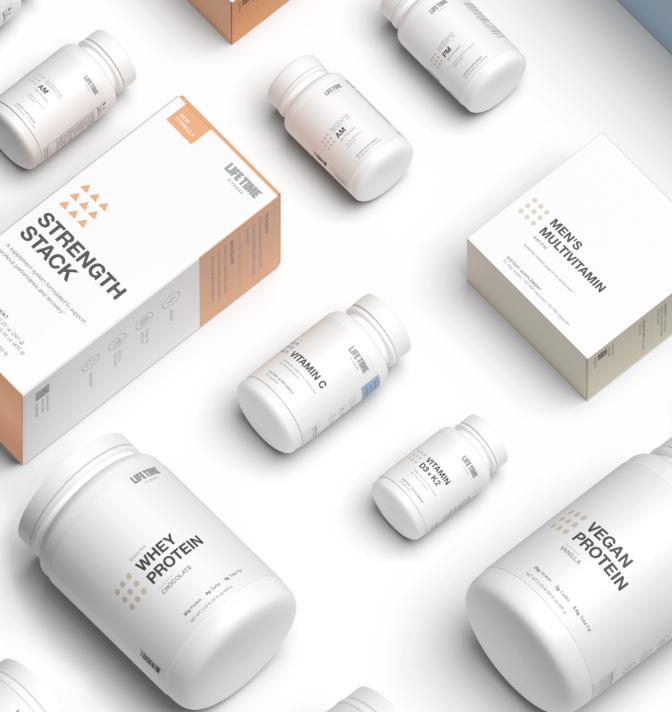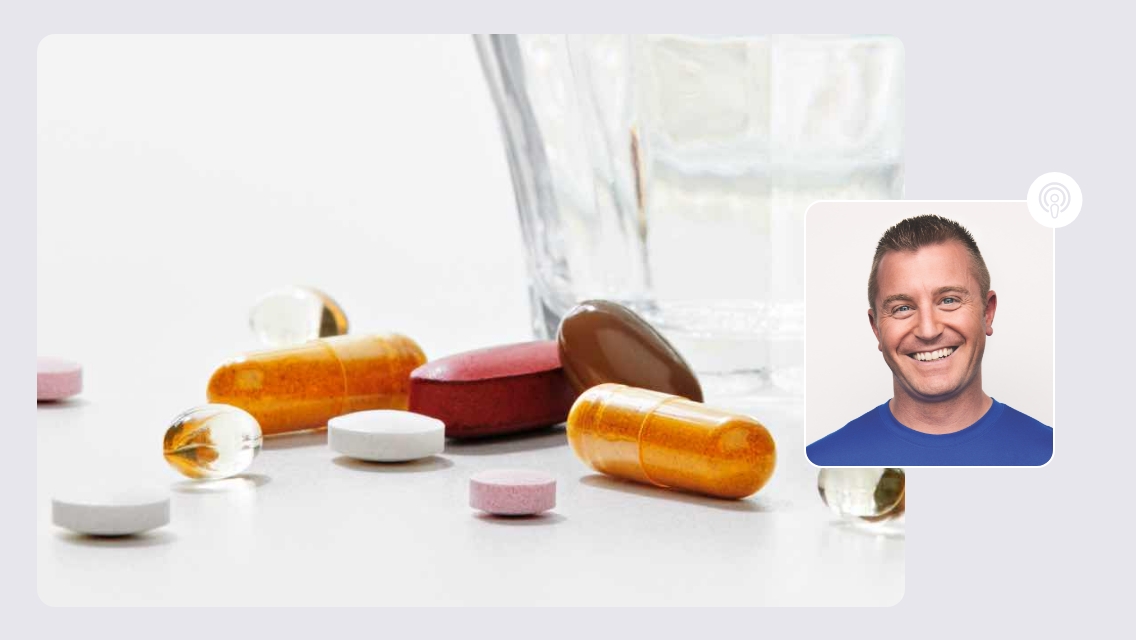“I don’t trust supplement quality; they aren’t regulated. I’m going to just get what I need from food.”
I’ve heard these statements from countless people who are first embarking on a health and fitness journey. Based on the general reputation of the supplement industry, I can appreciate the initial sentiments and concerns. However, these notions are a bit misguided.
The truth is, most of us are not obtaining optimal levels of nutrients from food. This is due to a combination of factors: inadequate intake (especially produce), increased needs (due to chronic stress or certain medications), and trouble breaking down and absorbing them effectively (such as in digestive imbalances).
The supplement industry also does have oversight from certain governing bodies, including the Food and Drug Administration (FDA) and Federal Trade Commission (FTC). While this doesn’t always provide a full guarantee for efficacy, it’s not accurate to say that supplement manufacturers can run amok with the freedom to do and claim anything they please.
That being said, there’s a reason that the supplement industry has earned a sketchy reputation: It’s had its fair share of dirty laundry.
In recent years, the lid has blown off several well-known brands and companies after testing revealed that key ingredients on their package labels were missing in the actual products. Then, a consumer advocacy group, the Clean Label Project, exposed alarming levels of contaminants in several common supplement brands. Headline after headline has exposed hidden and potentially dangerous ingredients — including unlabeled pharmaceutical drugs — found in some weight loss, sexual performance-enhancing, and muscle-building supplements.
It’s disappointing that a few bad companies use cost-cutting shortcuts at the expense of their customers’ health. Understandably, this taints the broader perception of the industry, even though there are companies that offer beneficial products while prioritizing customers’ health and safety.
The widespread confusion and distrust are precisely why Life Time decided more than two decades ago that it was essential we have control over formulation, ingredient selection, production, and final testing on what is offered on our shelves and online store. Through carefully selected partnerships and rigorous quality control standards — along with collaboration with registered dietitians — the supplements we offer are the same ones we use for ourselves and our families.
As a result, when our clients combine these quality supplements with healthy nutrition and exercise strategies, they consistently report back improvements to their general health, wellbeing, and vitality, as well as exercise performance and blood test markers.
Here are five checkpoints to use as a first-pass screening to try to weed out the bad guys when it comes to what you’re including in your daily routine. If you see any of the following ingredients on a supplement label, take pause — it’s a sign that the manufacturer could be prioritizing their profits over your health.
1. Certain synthetic vitamin forms
If you look at the back of a multivitamin label, you’ll see a lot of long, complex-looking chemical names associated with the various nutrient components of the product. These names are sometimes found line-by-line on the supplement facts panel, listed right next to the name of the vitamin. In other cases, the supplement facts panel lists only the vitamin name on each line, and the forms of the nutrients are all listed together in the ingredients, which can make it harder to decipher which chemical names belong to which nutrient.
Different nutrient forms have varying degrees of absorption and utilization, and unless you know what to look for, it’s hard to tell if a product has superior or inferior forms.
I’ve found that in many cases, gut-checking a few select vitamins is a good place to start, even if you’re not familiar with the entire label. Start by evaluating the form of vitamin B12, vitamin B6, and folate in a given supplement to serve as an indicator of the overall nutrient quality included in a particular brand:
| Nutrient | Consider This | Instead Of This |
|---|---|---|
| Vitamin B12 | Methylcobalamin
Adenosylcobalamin |
Cyanocobalamin |
| Vitamin B6 | Pyridoxal 5’-Phosphate (P5P) | Pyridoxine Hydrochloride (HCL) |
| Vitamin B9 (Folate) | 5-Methyl-Tetrahydrofolic Acid
L-5-Methyltetrahydrofolate 5-MTHF |
Folic Acid |
The forms in the “consider this” column are considered more “active” forms of the nutrient. By supplementing with the more active form, your body is more likely to be able to use it efficiently. If the form is not “active,” your body first has to convert it to that form, which can create buildup of the less usable form. At best, this would provide less benefit, while at worst, it could lead to harmful levels.
Many of us also have genetic predispositions that make the conversion of synthetic nutrient forms to active nutrient forms less efficient. In these cases, we might be taking a supplement with just a hope that we’re able to use it effectively.
Take the chart above for example. The cyanocobalamin form of vitamin B12 would need to be converted in the liver to the more active form, methylcobalamin, which some of us have trouble doing. For vitamin B6, the less desirable form of pyridoxine hydrochloride can potentially interfere with the body’s ability to use the active form of P5P well. If you choose the cheaper folic acid over a methylated form of vitamin B9 or folate, it may create too much build up of folic acid in your body as well as mask a deficiency in vitamin B12.
While the superior vitamin forms are more expensive, they can be worth it for those looking to prioritize efficacy.
2. Mineral oxides, carbonates, and salts
Minerals can get a bit tricky. Not only do they have to be obtained through food or supplements since the body can’t make them, but they also can compete with each other for absorption. Many also require stomach acid to be effectively broken down and utilized, and as we get older or take certain medications (such as proton pump inhibitors), we’re prone to decreasing stomach acid and digestive enzymes.
Lower quality supplements (that cost less to manufacturer) are often harder to break down and pass through the digestive lining. These inferior options can sometimes be found in the form of mineral carbonates, mineral salts, or oxide forms.
Check labels to see if your supplement contains zinc oxide or magnesium oxide, as both of those provide issues with poor absorbability. (If zinc oxide sounds familiar, it’s likely because it’s the form of zinc used in some sunscreens and in diaper rash cream.) Some studies have shown that, when ingested, certain individuals have nearly zero capability to absorb zinc from zinc oxide. Magnesium oxide, on the other hand, can be used as a laxative, which is indicative of its poor absorbability.
Many higher quality supplements will use mineral chelates (pronounced “kee-laits”). This form of mineral is wrapped in either amino acids (protein building blocks) or organic acids. By forming a complex (being wrapped) with these acids, it’s thought to improve the breakdown and absorption rates of minerals.
Chelated versions will typically have “chelate” or “bisglycinate” listed in the ingredients and on the label. When supplements contain bisglycinate, take note: It takes up a lot of physical space, so you’re likely going to be taking several capsules.
3. Unnecessary binders, coatings, preservatives, or excipients
To manufacture a supplement successfully, production processes must run smoothly while also maintaining product stability, adequately preserving the integrity of nutrients, and allowing the delivery form to be broken down and usable by the body by the time we actually take them. Because of all these factors, it’s necessary for all supplements to contain additives beyond just the active ingredients.
Unsurprisingly, these additives, or binders, coating, preservatives, and excipients (which help deliver active substances), vary significantly in both cost and impact on the final product.
Common ones to consider avoiding include:
- Magnesium stearate: This is a flow agent that assists in ease of manufacturing. Some studies have shown it can slow down the rate that a supplement dissolves in your body. It’s also suspected to decrease nutrient absorption, which is ironic considering increasing absorption is one of the reasons we supplement in the first place.
- Polyethylene glycol: This is often used as a pill coating. Take note: It has a laxative effect.
- Lactose, or milk sugar: While not inherently a high-alert issue, it can cause digestive upset in some. It’s not always disclosed on a label if it’s used to dilute a raw ingredient. Hidden lactose is seen in a lot of over the counter vitamin D supplements. (Note: Life Time’s vitamin D supplement does not contain lactose.)
4. Artificial sweeteners, flavors, and dyes
When it comes to colors, flavors, and sweeteners, aim to go all-natural whenever possible. From our supplement line to the food we offer in the LifeCafe, this is a non-negotiable standard at Life Time.
Some evidence shows possible links between artificial sweeteners and imbalanced gut health and blood-sugar regulation. Other research suggests that with our four-fold increase in consumption in the last 50 years, artificial flavors could be a potential contributor to ADHD and behavioral issues, and artificial colors and dyes in regular, large doses have been suggested to have carcinogenic activity.
Artificial ingredients to look out for include:
- Synthetic colors such as FD&C, brilliant blue, Red 40, Yellow 5, and Yellow 6
- Artificial sweeteners such as sucralose, acesulfame potassium, and aspartame
- Artificial flavors
While these ingredients shouldn’t cause fear or panic, there’s no health benefit to using them — and there are supplement options available with better alternatives. Plus, considering that most supplements are taken as part of a daily routine, it can be prudent to make some swaps.
For powder-based supplements, top-tier options tend to use natural flavors and colors, and are usually sweetened with stevia (sometimes with a gram or two of sugar to offset any bitterness), erythritol, allulose, or monk fruit. Colors can come from plants, such as beet juice or beetroot powder, and flavors are sourced from natural options, listed as “natural chocolate,” for example.
5. Gummies and tablets
Depending on the supplement, the delivery method — capsule, tablet, liquid, gummy, etc. — has a significant impact on if the ingredients get used by the body and to what degree.
Tablets are often compressed and glued together with binders, making them difficult to break down in your gastrointestinal tract. Gummies, while a genius marketing strategy, have limited space and cannot physically contain therapeutic amounts of certain vitamins and minerals — and they almost always contain a lot of added sugar, artificial sweeteners, or colors.
Here’s a closer look at the main types:
| Gummies | Tablets | Powder-Filled Capsules |
|---|---|---|
| Often contain added sugars and artificial colors and flavors | Typically contain binders, fillers, and glues | Nutrients are “loose” and therefore more easily absorbed |
| Gelatin may be hard to digest for some | May not fully dissolve and can pass through into stool | Tend to be more easily digested and utilized |
| Tends to be lower in potency and hard to deliver high doses, especially for minerals | Difficult to pack potency and high doses with nutrients | More easily accommodate high-potency formulas |
Liquids and powders (including powder-containing capsules) tend to be easier to break down. These forms allow the active ingredients to be more easily released in the digestive tract so they can be better absorbed. They also have more capacity, and therefore increased potency.
While capsules are not as fun as the weakly vitamin-laced, ineffective candy gummies, they are a much better use of your money and efforts.
Wrapping Up
The supplement world can be a confusing place. For my clients, I suggest prioritizing quality above all else, especially in the case of supplements — it becomes all the more important when you’re taking in concentrated ingredients regularly.
The suggestions above are by no means guarantees for quality, purity, or solid manufacturing practices. However, I have seen that supplement options that pass some of the standards I listed are a lot more likely to be trustworthy and from manufacturers that have earned a solid reputation.
Hopefully this gives you a few quality checkpoints to run through as you select your supplement options. At Life Time, we firmly believe you deserve the absolute best offerings with consistent, uncompromising quality — and supplements are no exception.
References





